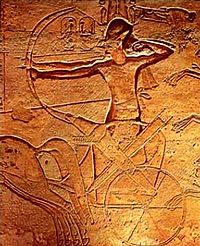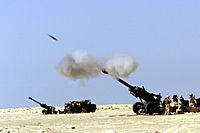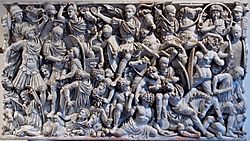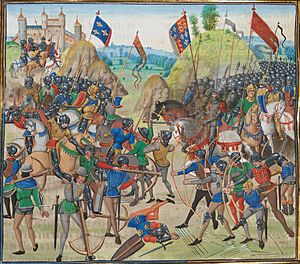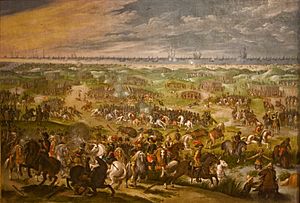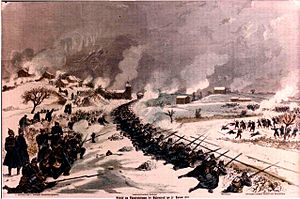Military history facts for kids
Military history is the history of what happened in the history of humanity that are considered to be conflicts. This could mean anything as small as a fight between two tribes or a conflict as large as a world war. Military historians record military history.
Contents
Technological evolution
The nature of warfare never changes, only its superficial manifestations. Joshua and David, Hector and Achilles would recognize the combat that our soldiers and Marines have waged in the alleys of Somalia and Iraq. The uniforms evolve, bronze gives way to titanium, arrows may be replaced by laser-guided bombs, but the heart of the matter is still killing your enemies until any survivors surrender and do your will.
New weapons development can dramatically alter the face of war, the cost of warfare, the preparations, and the training of soldiers and leaders. A rule of thumb is that if your enemy has a potentially war winning weapon, you have to either match it or neutralize it.
Ancient era
Chariots originated around 2000 BC. The chariot was an effective, fast weapon; while one man controlled the maneuvering of the chariot, a second bowman could shoot arrows at enemy soldiers. These became crucial to the maintenance of several governments, including the New Egyptian Kingdom and the Shang Dynasty and the nation states of early to mid Zhou dynasty.
Some of the military unit types and technologies which were developed in the ancient world are:
For settled agrarian civilizations, the infantry became the core of military action. The infantry started as opposing armed groups of soldiers underneath commanders. The Greeks and early Romans used rigid, heavily armed phalanxes. The Macedonians and Hellenistic states would adopt phalanx formations with sarissa pikemen. The Romans would later adopt more flexible maniples from their neighbors which made them extremely successful in the field of battle. The kingdoms of the Warring States in East Asia also adopted infantry combat, a transition from chariot warfare from centuries earlier.
Cavalry became an important tool. In the Sicilian Expedition, led by Athens in an attempt to subdue Syracuse, the well-trained Syracusan cavalry became crucial to the success of the Syracusans. Macedonian Alexander the Great effectively deployed his cavalry forces to secure victories. In battles such as the Battle of Cannae of the Second Punic War, and the Battle of Carrhae of the Roman-Persian Wars, the importance of the cavalry would be repeated.
There were also horse archers, who had the ability to shoot on horseback – the Parthians, Scythians, Mongols, and other various steppe people were especially fearsome with this tactic. By the 3rd–4th century AD, heavily armored cavalry became widely adopted by the Eastern Roman Empire, Sassanids, Eastern Han Dynasty and Three Kingdoms, etc.
The early Indo-Iranians developed the use of chariots in warfare. The scythed chariot was later invented in India and soon adopted by the Persian Empire.
War elephants were sometimes deployed for fighting in ancient warfare. They were first used in India and later adopted by both the Persians and Alexander the Great against one another. War elephants were also used in the Battle of the Hydaspes River, and by Hannibal in the Second Punic War against the Romans.

Naval warfare was often crucial to military success. Early navies used sailing ships without cannons; often the goal was to ram the enemy ships and cause them to sink. There was human oar power, often using slaves, built up to ramming speed. Galleys were used in the 3rd millennium BC by the Cretans. The Greeks later advanced these ships.
In 1210 BC, the first recorded naval battle was fought between Suppiluliuma II, king of the Hittites, and Cyprus, which was defeated. In the Persian Wars, the navy became of increasing importance.
Triremes were involved in more complicated sea-land operations. Themistocles helped to build up a stronger Greek navy, composed of 310 ships, and defeated the Persians at the Battle of Salamis, ending the Persian invasion of Greece.
In the First Punic War, the war between Carthage and Rome started with an advantage to Carthage because of their naval experience. A Roman fleet was built in 261 BC, with the addition of the corvus that allowed Roman soldiers on board the ships to board the enemy ships. The bridge would prove effective at the Battle of Mylae, resulting in a Roman victory.
The Vikings, in the 8th century AD, invented a ship propelled by oars with a dragon decorating the prow, hence called the Drakkar. The 12th century AD Song Dynasty invented ships with watertight bulk head compartments while the 2nd century BC Han Dynasty invented rudders and sculled oars for their warships.
Fortifications are important in warfare. Early hill-forts were used to protect inhabitants in the Iron Age. They were primitive forts surrounded by ditches filled with water. Forts were then built out of mud bricks, stones, wood, and other available materials. Romans used rectangular fortresses built out of wood and stone. As long as there have been fortifications, there have been contraptions to break in, dating back to the times of Romans and earlier. Siege warfare is often necessary to capture forts.
Middle-ages
Some of the military unit types and technologies which were used in the medieval period are:
- Artillery
- Cataphract
- Condottieri
- Fyrd
- Rashidun
- Mobile guard
- Mamluk
- Janissary
- Knight (see also: Chivalry)
- Crossbow
- Pikeman
- Samurai
- Sipahi
- Trebuchet
Bows and arrows were often used by combatants. Egyptians shot arrows from chariots effectively. The crossbow was developed around 500 BC in China, and was used a lot in the Middle Ages. The English/Welsh longbow from the 12th century also became important in the Middle Ages. It helped to give the English a large early advantage in the Hundred Years' War, even though the English were eventually defeated. The Battle of Crécy and the Battle of Agincourt are excellent examples of how to destroy an enemy using a longbow. It dominated battlefields for over a century.
The rise of gunpowder
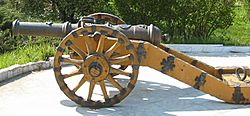
In the 10th century, the invention of gunpowder led to many new weapons that were improved over time. Black powder was used in China since the 4th century, but it was not used as a weapon until the 11th century. Until the mid-15th century, guns were held in one hand, while the explosive charge was ignited by the other hand. Then came the matchlock, which was used widely until around the 1720s. Leonardo da Vinci made drawings of the wheel lock which made its own sparks. Eventually, the matchlock was replaced by the flintlock. Cannons were first used in Europe in the early 14th century, and played a vital role in the Hundred Years' War. The first cannons were simply welded metal bars in the form of a cylinder, and the first cannonballs were made of stone. By 1346, at the Battle of Crécy, the cannon had been used; at the Battle of Agincourt they would be used again.
At the beginning of the 16th century, the first European fire ships were used. Ships were filled with flammable materials, set on fire, and sent to enemy lines. This tactic was successfully used by Francis Drake to scatter the Spanish Armada at the Battle of Gravelines, and would later be used by the Chinese, Russians, Greeks, and several other countries in naval battles.
Naval mines were invented in the 17th century, though they were not used in great numbers until the American Civil War. They were used heavily in the First and Second World Wars. Air-deployed naval mines were used to mine the North Vietnamese port of Haiphong during the Vietnam War. The Iraqi Navy of Saddam Hussein used naval mines extensively during the Tanker War, as part of the Iran–Iraq War.
The first navigable submarine was built in 1624 by Cornelius Drebbel, it could cruise at a depth of 15 feet (5 m). However, the first military submarine was constructed in 1885 by Isaac Peral.
The Turtle was developed by David Bushnell during the American Revolution. Robert Fulton then improved the submarine design by creating the Nautilus.
The Howitzer, a type of field artillery, was developed in the 17th century to fire high trajectory explosive shells at targets that could not be reached by flat trajectory projectiles.
Organizational changes resulting in better training and intercommunication, made the concept combined arms possible, allowing the use of infantry, cavalry, and artillery in a coordinated way.
Bayonets also became of wide usage to infantry soldiers. Bayonet is named after Bayonne, France where it was first manufactured in the 16th century. It is used often in infantry charges to fight in hand-to-hand combat. General Jean Martinet introduced the bayonet to the French army. They were used heavily in the American Civil War, and continued to be used in modern wars like the Invasion of Iraq.
Balloons were first used in warfare at the end of the 18th century. It was first introduced in Paris of 1783; the first balloon traveled over 5 miles (8 km). Previously military scouts could only see from high points on the ground, or from the mast of a ship. Now they could be high in the sky, signalling to troops on the ground. This made it much more difficult for troop movements to go unobserved.
At the end of the 18th century, iron-cased artillery rockets were successfully used militarily in India against the British by Tipu Sultan of the Kingdom of Mysore during the Anglo-Mysore Wars. Rockets were generally inaccurate at that time, though William Hale, in 1844, was able to develop a better rocket. The new rocket no longer needed the rocket stick, and had a higher accuracy.
In the 1860s there were a series of advancements in rifles. The first repeating rifle was designed in 1860 by a company bought out by Winchester, which made new and improved versions. Springfield rifles arrived in the mid-19th century also. Machine guns arrived in the late 19th century. Automatic rifles and light machine guns first arrived at the beginning of the 20th century.
In the later part of the 19th century, the self-propelled torpedo was developed. The HNoMS Rap was the world's first torpedo boat.
Modern technologies
At the start of the World Wars, various nations had developed weapons that were a surprise to their adversaries, leading to a need to learn from this, and alter how to combat them. Flame throwers were first used in the First World War. The French were the first to introduce the armored car in 1902. Then in 1918, the British produced the first armored troop carrier. Many early tanks were proof of concept but impractical until further development. In World War I, the British and French held a crucial advantage due to their superiority in tanks; the Germans had only a few dozen A7V tanks, as well as 170 captured tanks. The British and French both had several hundred each. The French tanks included the 13 ton Schneider-Creusot, with a 75 mm gun, and the British had the Mark IV and Mark V tanks.
On December 17, 1903, the Wright Brothers performed the first controlled, powered, heavier-than-air flight; it went 39 meters (120 ft). In 1907, the first helicopter flew, but it wasn't practical for usage. Aviation became important in World War I, in which several aces gained fame. In 1911 an aircraft took off from a warship for the first time. Landings on a cruiser were another matter. This led to the development of an aircraft carrier with a decent unobstructed flight deck.
Chemical warfare exploded into the public consciousness in World War I but may have been used in earlier wars without as much human attention. The Germans used gas-filled shells at the Battle of Bolimov on January 3, 1915. These were not lethal, however. In April 1915, the Germans developed a chlorine gas that was highly lethal, and used it to moderate effect at the Second Battle of Ypres. Gas masks were invented in matter of weeks, and poison gas proved ineffective at winning battles. It was made illegal by all nations in the 1920s.
World War II gave rise to even more technology. The worth of the aircraft carrier was proved in the battles between the United States and Japan like the Battle of Midway. Radar was independently invented by the Allies and Axis powers. It used radio waves to detect objects. Molotov cocktails were invented by General Franco in the Spanish Civil War, directing the Nationalists to use them against Soviet tanks in the assault on Toledo. The atomic bomb was developed by the Manhattan Project and dropped on Hiroshima and Nagasaki in 1945, quickly ending World War II.
During the Cold War, the main powers engaged in a Nuclear arms race. In the space race, both nations attempted to launch human beings into space to the moon. Other technological advances centered on intelligence (like the spy satellite) and missiles (ballistic missiles, cruise missiles). Nuclear submarine, invented in 1955. This meant submarines no longer had to surface as often, and could run more quietly. They evolved into becoming underwater missile platforms.
Periods of military history
The influence of technology on military history, and evident Eurocentrism are nowhere more pronounced than in the attempt by the military historians to divide their subject area into more manageable periods of analysis. While general discipline of history subdivides history into Ancient history (Classical antiquity), Middle Ages (Europe, 4th century – 15th century), Early Modern period (Europe, 14th century – 18th century), Modern era (Europe, 18th century – 20th century), and the Post-Modern (USA, 1949–present), the periodisation below stresses technological change in its emphasis, particularly the crucial dramatic change during the Gunpowder warfare period.
Periodisation is not uniformly applied through time and space, affirming the claims of Eurocentrism from regional historians. For example, what might be described as prehistoric warfare is still practised in a few parts of the world. Other eras that are distinct in European history, such as the era of medieval warfare, may have little relevance in East Asia.
Ancient warfare
Much of what we know of ancient history is the history of militaries: their conquests, their movements, and their technological innovations. There are many reasons for this. Kingdoms and empires, the central units of control in the ancient world, could only be maintained through military force. Due to limited agricultural ability, there were relatively few areas that could support large communities, so fighting was common.
Weapons and armor, designed to be sturdy, tended to last longer than other artifacts, and thus a great deal of surviving artifacts recovered tend to fall in this category as they are more likely to survive. Weapons and armor were also mass-produced to a scale that makes them quite plentiful throughout history, and thus more likely to be found in archaeological digs.
Such items were also considered signs of prosperity or virtue, and thus were likely to be placed in tombs and monuments to prominent warriors. And writing, when it existed, was often used for kings to boast of military conquests or victories.
Writing, when used by the common man, also tended to record such events, as major battles and conquests constituted major events that many would have considered worthy of recording either in an epic such as the Homeric writings pertaining to the Trojan War, or even personal writings. Indeed, the earliest stories center on warfare, as war was both a common and dramatic aspect of life; the witnessing of a major battle involving many thousands of soldiers would be quite a spectacle, even today, and thus considered worthy both of being recorded in song and art, but also in realistic histories, as well as being a central element in a fictional work.
Lastly, as nation states evolved and empires grew, the increased need for order and efficiency lead to an increase in the number of records and writings. Officials and armies would have good reason for keeping detailed records and accounts involving any and all things concerning a matter such as warfare that in the words of Sun Tzu was "a matter of vital importance to the state". For all these reasons, military history comprises a large part of ancient history.
Notable militaries in the ancient world included the Egyptians, Babylonians, Persians, Ancient Greeks (notably the Spartans and Macedonians), Indians (notably the Magadhas, Gangaridais, Gandharas and Cholas), Early Imperial Chinese (notably the Qin and Han Dynasties), Xiongnu Confederation, Ancient Romans, and Carthaginians.
The fertile crescent of Mesopotamia was the center of several prehistoric conquests. Mesopotamia was conquered by the Sumerians, Akkadians, Babylonians, Assyrians and Persians. Iranians were the first nation to introduce cavalry into their army.
Egypt began growing as an ancient power, but eventually fell to the Libyans, Nubians, Assyrians, Persians, Greeks, Romans, Byzantines and Arabs.
The earliest recorded battle in India was the Battle of the Ten Kings. The Indian epics Mahabharata and Ramayana are centered on conflicts and refer to military formations, theories of warfare and esoteric weaponry. Chanakya's Arthashastra contains a detailed study on ancient warfare, including topics on espionage and war elephants.
Alexander the Great invaded Northwestern India and defeated King Porus in the Battle of the Hydaspes River. The same region was soon re conquered by Chandragupta Maurya after defeating the Macedonians and Seleucids. He also went on to conquer the Nanda Empire and unify Northern India. Most of Southern Asia was unified under his grandson Ashoka the Great after the Kalinga War, though the empire collapsed not long after his reign.
In China, the Shang Dynasty and Zhou Dynasty had risen and collapsed. This led to a Warring States period, in which several states continued to fight with each other over territory. Philosopher-strategists such as Confucius and Sun Tzu wrote various manuscripts on ancient warfare (as well as international diplomacy).
The Warring States era philosopher Mozi (Micius) and his Mohist followers invented various siege weapons and siegecraft, including the Cloud Ladder (a four-wheeled, extendable ramp) to scale fortified walls during a siege of an enemy city. The warring states were first unified by Qin Shi Huang after a series of military conquests, creating the first empire in China.
His empire was succeeded by the Han Dynasty, which expanded into Central Asia, Northern China/Manchuria, Southern China, and present day Korea and Vietnam. The Han came into conflict with settled people such as the Wiman Joseon, and proto-Vietnamese Nanyue. They also came into conflict with the Xiongnu (Huns), Yuezhi, and other steppe civilizations.
The Han defeated and drove the Xiongnus west, securing the city-states along the silk route that continued into the Parthian Empire. After the decline of central imperial authority, the Han Dynasty collapsed into an era of civil war and continuous warfare during the Three Kingdoms period in the 3rd century AD.
The Achaemenid Persian Empire was founded by Cyrus the Great after conquering the Median Empire, Neo-Babylonian Empire, Lydia and Asia Minor. His successor Cambyses went on to conquer the Egyptian Empire, much of Central Asia, and parts of Greece, India and Libya. The empire later fell to Alexander the Great after defeating Darius III. After being ruled by the Seleucid dynasty, the Persian Empire was subsequently ruled by the Parthian and Sassanid dynasties, which were the Roman Empire's greatest rivals during the Roman-Persian Wars.
In Greece, several city-states rose to power, including Athens and Sparta. The Greeks successfully stopped two Persian invasions, the first at the Battle of Marathon, where the Persians were led by Darius the Great, and the second at the Battle of Salamis, a naval battle where the Greek ships were deployed by orders of Themistocles and the Persians were under Xerxes I, and the land engagement of the Battle of Plataea.
The Peloponnesian War then erupted between the two Greek powers Athens and Sparta. Athens built a long wall to protect its inhabitants, but the wall helped to facilitate the spread of a plague that killed about 30,000 Athenians, including Pericles. After a disastrous campaign against Syracuse, the Athenian navy was decisively defeated by Lysander at the Battle of Aegospotami.
The Macedonians, underneath Philip II of Macedon and Alexander the Great, invaded Persia and won several major victories, establishing Macedonia as a major power. However, following Alexander's death at an early age, the empire quickly fell apart.
Meanwhile, Rome was gaining power, following a rebellion against the Etruscans. During the three Punic Wars, the Romans defeated the neighboring power of Carthage. The First Punic War centered on naval warfare. The Second Punic War started with Hannibal's invasion of Italy by crossing the Alps. He famously won the encirclement at the Battle of Cannae. However, after Scipio invaded Carthage, Hannibal was forced to follow and was defeated at the Battle of Zama, ending the role of Carthage as a power.
After defeating Carthage the Romans went on to become the Mediterranean's dominant power, successfully campaigning in Greece, (Aemilius Paulus decisive victory over Macedonia at the Battle of Pydna), in the Middle East (Lucius Licinius Lucullus, Gnaeus Pompeius Magnus), in Gaul (Gaius Julius Caesar) and defeating several Germanic tribes (Gaius Marius, Germanicus). While Roman armies suffered several major losses, their large population and ability (and will) to replace battlefield casualties, their training, organization, tactical and technical superiority enabled Rome to stay a predominant military force for several centuries, utilizing well trained and maneuverable armies to routinely overcome the much larger "tribal" armies of their foes (see Battles of Aquae Sextiae, Vercellae, Tigranocerta, Alesia).
In 54 BC the Roman triumvir Marcus Licinius Crassus took the offensive against the Parthian Empire in the east. In a decisive battle at Carrhae Romans were defeated and the golden Aquilae (legionary battle standards) were taken as trophies to Ctesiphon. The battle was one of the worst defeats suffered by the Roman Republic in its entire history.
While successfully dealing with foreign opponents, Rome experienced numerous civil wars, notably the power struggles of Roman generals such as Marius and Sulla during the end of the Republic. Caesar was also notable for his role in the civil war against the other member of the Triumvirate (Pompey) and against the Roman Senate.
The successors of Caesar – Octavian and Mark Anthony, also fought a civil war with Caesar's assassins (Senators Brutus, Cassius, etc.). Octavian and Mark Anthony eventually fought another civil war between themselves to determine the sole ruler of Rome. Octavian emerged victorious and Rome was turned into an empire with a huge standing army of professional soldiers.
By the time of Marcus Aurelius, the Romans had expanded to the Atlantic Ocean in the west and to Mesopotamia in the east and controlled Northern Africa and Central Europe up to the Black Sea. However, Aurelius marked the end of the Five Good Emperors, and Rome quickly fell into decline.
The Huns, Goths, and other barbaric groups invaded Rome, which continued to suffer from inflation and other internal strifes. Despite the attempts of Diocletian, Constantine I, and Theodosius I, western Rome collapsed and was eventually conquered in 476. The Byzantine empire continued to prosper, however.
Medieval warfare
When stirrups came into use some time during the Dark Ages militaries were forever changed. This invention coupled with technological, cultural, and social developments had forced a dramatic transformation in the character of warfare from antiquity, changing military tactics and the role of cavalry and artillery.
Similar patterns of warfare existed in other parts of the world. In China around the 5th century armies moved from massed infantry to cavalry based forces, copying the steppe nomads. The Middle East and North Africa used similar, if often more advanced, technologies than Europe.
In Japan the Medieval warfare period is considered by many to have stretched into the 19th century. In Africa along the Sahel and Sudan states like the Kingdom of Sennar and Fulani Empire employed Medieval tactics and weapons well after they had been supplanted in Europe.
In the Medieval period, feudalism was firmly implanted, and there existed many landlords in Europe. Landlords often owned castles to protect their territory.
The Islamic Arab Empire began rapidly expanding throughout the Middle East, North Africa, and Central Asia, initially led by Rashidun Caliphate, and later under the Umayyads. While their attempts to invade Europe by way of the Balkans were defeated by Byzantium and Bulgaria, the Arabs expanded to the Iberian Peninsula in the west and the Indus Valley in the east. The Abassids then took over the Arab Empire, though the Umayyads remained in control of Islamic Spain.
At the Battle of Tours, the Franks under Charles Martel stopped short a Muslim invasion. The Abassids defeated the Tang Chinese army at the Battle of Talas, but were later defeated by the Seljuk Turks and the Mongols centuries later, until the Arab Empire eventually came to an end after the Battle of Baghdad in 1258.
In China, the Sui Dynasty had risen and conquered the Chen Dynasty of the south. They invaded Vietnam (northern Vietnam had been in Chinese control since the Han Dynasty), fighting the troops of Champa, who had cavalry mounted on elephants. After decades of economic turmoil and a failed invasion of Korea, the Sui collapsed and was followed by the Tang Dynasty, who fought with various Turkic groups, the Tibetans of Lhasa, the Tanguts, the Khitans, and collapsed due to political fragmentation of powerful regional military governors (jiedushi). The innovative Song Dynasty followed next, inventing new weapons of war that employed the use of Greek Fire and gunpowder (see section below) against enemies such as the Jurchens.
The Mongols under Genghis Khan, Ögedei Khan, Möngke Khan, and Kublai Khan conquered most of Eurasia. They took over China, Persia, Turkestan, and Russia. After Kublai Khan took power and created the Yuan Dynasty, the divisions of the empire ceased to cooperate with each other, and the Mongol Empire was only nominally united.
In New Zealand, prior to European discovery, oral histories, legends and whakapapa include many stories of battles and wars. Māori warriors were held in high esteem. One group of Polynesians migrated to the Chatham Islands, where they developed the largely pacifist Moriori culture. Their pacifism left the Moriori unable to defend themselves when the islands were invaded by mainland Māori in the 1830s.
They proceeded to massacre the Moriori and enslave the survivors. Warrior culture also developed in the isolated Hawaiian Islands. During the 1780s and 1790s the chiefs and alii were constantly fighting for power. After a series of battles the Hawaiian Islands were united for the first time under a single ruler who would become known as Kamehameha I.
Gunpowder warfare
After gunpowder weapons were first developed in Song Dynasty China (see also Technology of Song Dynasty), the technology later spread west to the Ottoman Empire, from where it spread to the Safavid Empire of Persia and the Mughal Empire of India. The arquebus was later adopted by European armies during the Italian Wars of the early 16th century.
This all brought an end to the dominance of armored cavalry on the battlefield. The simultaneous decline of the feudal system – and the absorption of the medieval city-states into larger states – allowed the creation of professional standing armies to replace the feudal levies and mercenaries that had been the standard military component of the Middle Ages.
In Africa, Ahmad ibn Ibrihim al-Ghazi, was the first African commander to use gunpowder on the continent in the Ethiopian–Adal War, that lasted for fourteen years (1529–1543).
The period spanning between the 1648 Peace of Westphalia and the 1789 French Revolution is also known as Kabinettskriege (Princes' warfare) as wars were mainly carried out by imperial or monarchics states, decided by cabinets and limited in scope and in their aims. They also involved quickly shifting alliances, and mainly used mercenaries.
Over the course of the 18th-19th centuries all military arms and services underwent significant developments that included a more mobile field artillery, the transition from use of battalion infantry drill in close order to open order formations and the transfer of emphasis from the use of bayonets to the rifle that replaced the musket, and virtual replacement of all types of cavalry with the universal dragoons, or mounted infantry.
Industrial warfare
As weapons—particularly small arms—became easier to use, countries began to abandon a complete reliance on professional soldiers in favor of conscription. Technological advances became increasingly important; while the armies of the previous period had usually had similar weapons, the industrial age saw encounters such as the Battle of Sadowa, in which possession of a more advanced technology played a decisive role in the outcome.
Conscription was employed in industrial warfare to increase the number of military personnel that were available for combat. This was notably used by Napoleon Bonaparte and by almost all parties during the two World Wars.
Total war was used in industrial warfare, the objective being to prevent the opposing nation to engage in war. William Tecumseh Sherman's "March to the Sea" and Philip Sheridan's burning of the Shenandoah Valley during the American Civil War and the strategic bombing of enemy cities and industrial factories during World War II are examples of total warfare.
Modern warfare
In modern times, war has evolved from an activity steeped in tradition to a scientific enterprise where success is valued above methods. The notion of total war is the extreme of this trend. Militaries have developed technological advances rivaling the scientific accomplishments of any other field of study. Modern militaries benefit in the development of these technologies under the funding of the public, the leadership of national governments. What distinguishes modern military organizations from those previous is not their willingness to prevail in conflict by any method, but rather the technological variety of tools and methods available to modern battlefield commanders, from submarines to satellites, from knives to nuclear warheads.
Images for kids
-
The Canadian War Museum.
-
Relief of Ramses II located in Abu Simbel fighting at the Battle of Kadesh on a chariot.
-
Eighty Years' War, or Dutch Revolt against Spain, painting by Sebastiaen Vrancx
See also
 In Spanish: Historia militar para niños
In Spanish: Historia militar para niños


